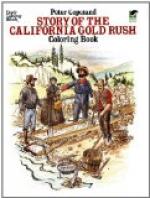The poppy is our best-known wild flower, planted by Mother Nature before white men ever visited these shores. When the Spanish settled here they called the poppy copa de oro, or cup of gold. The gold hunters spoke of it as the California gold flower, and sent the pressed poppies home in their letters. But its correct name is the Eschscholtzia (esh-sholt’si-a), from the name of a German botanist and naturalist, who studied the plant and wrote about it almost a hundred years ago.
From February to May the poppies are most plentiful, but a few may be found almost every month in the year. Have you noticed the finely cut green leaves, and the pointed green nightcap that covers each bud till the morning sunshine coaxes off the cap and unfolds the four satiny golden petals? The flowers love the sun and close up on dark, cloudy days, or if brought into the house. But put them in a sunny window the next morning, and you may watch the cups of gold open to the light.
Some of the poppies are a deep orange-color, while others are a pale yellow. And as you walk through the fields you may pick a hundred at each step, so thick do the plants grow. The wild bees find a yellow dust called pollen or “bee-bread” in the poppy, the same golden powder that rubs off on your nose, when you put it too close to this cup of gold or to lilies.
Then in this “unfenced garden” were also the baby blue-eyes, whose pretty pale-blue blossoms come early in the spring, each one with a drop of honey at the foot of its honey path, as the black lines on its petals are called.
Can you name twenty kinds of wild flowers? Around San Francisco and the bay counties you will count, after the poppy and baby blue-eyes, the shining yellow buttercup, the blue and yellow lupines that grow in the sand, the tall thistle whose sharp, prickly leaves and thorny red blossoms spell “Let-me-alone,” the blue flag-lilies and red paint-brush, yellow cream-cups, and wild mustard, and an orange pentstemon. These with many yellow compositae or flowers like the dandelion, you will find growing on the windy hills and dry, sunny places. Hiding away in quiet corners are the blue-eyed grass, and a wild purple hyacinth, the scarlet columbine swinging its golden tassels, shy blue larkspur, a small yellow sunflower, and wild pink roses. Among the ferns in shady, wet nooks are white trilliums and a delicate pink bleeding-heart, while the wild blue violets and yellow pansies love the warm, rocky hillside.
Mariposas, or butterfly tulips of many colors, grow in the foot-hills and mountains. Perhaps our most beautiful wild flowers are the lilies, of which we have over a dozen kinds. In the redwood forests there is a tall, lovely pink lily, and many brown-spotted yellow tiger-lilies. Up in the mountain pines a snowy white Washington lily sometimes covers a mountain side with its tall stems bearing dozens of sweet waxen blossoms. In the wet, swampy places bright red, and many small orange lilies bloom in late summer.




